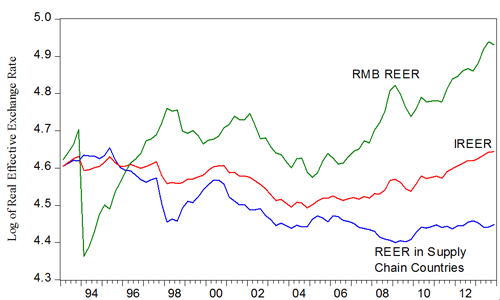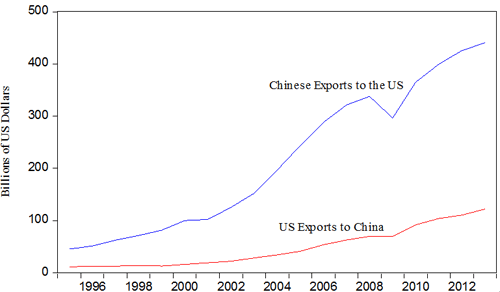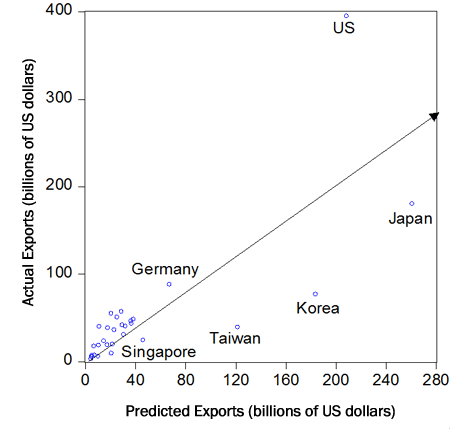| Interviewee | THORBECKE, Willem (Senior Fellow, RIETI) |
|---|---|
| Issue date / NO. | Research Digest No.09 |
| Download / Links |
Export-led growth was one of the great successes in economic history. Japan adopted this strategy in the 1950s, South Korea and Taiwan in the 1960s, the Association of Southeast Asian Nations (ASEAN) in the 1970s, and China in the 1990s. An export-oriented approach combined with high public and private saving rates, high rates of investment in physical and human capital, flexible labor markets, and pragmatic policies raised living standards at rates that are unparalleled in economic history.
Chinese economists, however, have enumerated problems with China's pursuit of export-led growth. Distortions such as inadequate enforcement of environmental laws have imposed costs on Chinese citizens. For instance, air pollution reduces people's life expectancy by many years, and polluting industries have contaminated the land and caused cancer. In addition, to maintain competitive exchange rates, China has accumulated trillions of dollars worth of U.S. Treasury bonds and other foreign exchange reserves. Returns from investing in U.S. Treasuries are far lower than the returns from investing in rural education and in remedying economic deficiencies in ways that would benefit the non-tradable sector. In addition, to sterilize the base money increases, the People's Bank of China has had to force banks to purchase central bank bills and to hold excess reserves. This erodes bank profitability and hinders small and medium-sized enterprises from obtaining loans. China's artificially weak currency has also transferred resources from Chinese consumers to producers, preventing Chinese workers from enjoying the fruits of their labors. For these reasons, it is interesting to study the determinants of China's exports and how China's trade can be rebalanced.
Evidence indicates that China's labor-intensive exports are sensitive to the renminbi (RMB) exchange rate. Profit margins for these goods are thin, and an RMB appreciation would cause labor-intensive exports to plummet.
For China's sophisticated exports such as tablet computers and smart phones, much of the value-added comes from parts and components produced in South Korea, Taiwan, Japan, and ASEAN. Exchange rates throughout the region should affect their price competitiveness. Recent results indicate that exchange rates throughout East Asia affect high end exports.
While the RMB has appreciated by 36% between 2005Q1 and 2013Q4, exchange rate in supply chain countries have depreciated. Thus, the competitiveness of China's sophisticated exports has barely changed. This contributes to China running a $400 billion surplus in these goods. On the other hand, the RMB appreciation has eroded the competitiveness of China's labor intensive exports, and China now runs a deficit in these goods. If central banks in East Asia slowed their reserve accumulation and gave greater play to market forces, the surpluses that they run in sophisticated exports and in their current account balances would generate a concerted appreciation of East Asian currencies and redirect final goods to Asian consumers.
Could you tell us what motivated you to undertake your research project?
THORBECKE: Export-led growth produced an economic miracle. In Japan, Saburo Okita and others developed this strategy in the 1950s. South Korea and Taiwan embraced this approach in the 1960s. The Association of Southeast Asian Nations (ASEAN) countries followed suit in the 1970s. An export-oriented approach combined with high public and private saving rates, high rates of investment in physical and human capital, flexible labor markets, and pragmatic policies helped increase per capita income in East Asia at rates that are unparalleled in economic history.
China adopted an outward orientation in the 1990s. Since then, its exports have followed two tracks. One track--processed exports--refers to final goods such as computers produced using parts and components that are imported primarily from East Asia. The other track--ordinary exports--refers to goods produced largely with domestic inputs. Initially, these were lower end goods such as apparel and toys, but over the last few years, ordinary exports have included sophisticated products such as smart phones. After 1993, China's processed exports increased 20 times to reach $860 billion in 2013 and its ordinary exports increased 25 times to reach $1.06 trillion.
Chinese economists, however, have pointed out several problems with this growth model. One is that factor market distortions have made China's exports more competitive. These include artificially low land prices, real interest rates, and real exchange rates as well as administered prices for fuel and electricity and environmental laws that are not rigorously enforced. These distortions have imposed large external costs on Chinese citizens. For instance, air pollution in China reduces people's life expectancy by many years and polluting industries have spewed toxins that contaminate the land and cause cancer.
Another problem with China's export-led growth is that, to maintain competitive exchange rates, it has accumulated trillions of dollars worth of U.S. Treasury bonds and other foreign exchange reserves.Private and social returns from investing in U.S. Treasuries are far lower than the returns available from investing in rural education in China and in remedying economic deficiencies in ways that would benefit the non-tradable sector. In addition, accumulating foreign reserves increases the money supply. To mop up liquidity, the People's Bank of China must force commercial banks to purchase central bank bills and to hold excess reserves. This erodes bank profitability and interferes with the allocation of credit. It also causes small and medium-sized enterprises that employ the majority of workers to face difficulties in obtaining bank loans. Thus, China's strategy leads to a large misallocation of resources.
A third problem is that an artificially weak currency is a distortion that transfers resources from Chinese consumers to producers. Consumers face higher import prices due to the weaker currency while producers can lower their export prices.
A fourth problem is that China's capacity to supply is so large that the rest of the world may not be able to continue absorbing China's exports. Increasing domestic demand and allowing Chinese workers to enjoy the fruits of their labor is thus of particular importance.
For these reasons, I have been interested in understanding the determinants of China's exports and how China's trade can be rebalanced.
What kind of data and methodology did you use to investigate China's trade and what problems did you encounter?
THORBECKE: Investigating China's ordinary exports that are produced primarily using local inputs has been straightforward. Since much of the value added of these goods comes from within China, the renminbi (RMB) exchange rate is a key determinant of their price competitiveness. Chinese policymakers have argued that profit margins for labor-intensive goods are thin and that an RMB appreciation would cause labor-intensive exports to plummet.
In one RIETI Discussion Paper (DP) I investigated the determinants of China's exports of carpets, clothing, fabrics, furniture, knitwear, leather, and yarns. I employed a panel data set including China's exports of these goods to 30 countries. I sought to explain exports using the bilateral RMB exchange rate with each of the importing countries, income in the importing countries, and a weighted bilateral exchange rate between the 17 other leading exporters of these labor-intensive goods and each of the importing countries. This last variable was included to control for competition between China and other countries in third markets. China's capital stock in manufacturing was also included to control for supply-side factors.
The results indicate that an appreciation of the RMB would substantially reduce China's labor-intensive exports. The results also reveal that an increase in foreign income, an appreciation among China's competitors, and an increase in the Chinese capital stock would raise China's exports. These findings are consistent with the claim that profit margins for China's labor-intensive exports are thin. They also indicate that there is substantial price competition between exporters of these lower end goods.
Investigating China's processed exports is much more difficult. Much of the value added of tablet computers and smart phones comes from parts and components produced in South Korea, Taiwan, and other predominantly East Asian economies. Thus, exchange rates throughout the region should affect the price competitiveness of these goods.
In a series of RIETI DPs, I constructed value-added exchange rates for processed exports. For instance, in a forthcoming DP, I used a panel data set on processed exports from China to the 24 leading importing countries. To compute an exchange rate across the supply chain for these countries, I calculated value-added in processed exports for China and the nine primary supply chain countries. The nine primary suppliers, ordered by their contribution in 2013, are South Korea, Taiwan, Japan, the United States, Malaysia, Thailand, Singapore, Germany, and the Philippines. I used this integrated bilateral real exchange rate between supply chain countries (including China) and each of the 24 importing countries as an explanatory variable. In addition, I included income in the importing countries and China's stock of foreign direct investment (FDI) as explanatory variables. China's stock of FDI is included because foreign invested enterprises play an important role in producing processed exports. The results indicate that exchange rates throughout the supply chain exert important effects on processed exports.
As a second test, I used China's aggregate processed exports to the world as the dependent variable. For explanatory variables, I employed the gross domestic product (GDP) in the rest of the world, the Chinese FDI stock, and real effective exchange rates (REER) in China and in the nine supply chain countries weighted by each of these countries' value added in processed exports. This variable is called the integrated exchange rate. The results again indicate that exchange rates throughout the supply chain and income in importing countries exert large effects on processed exports.
Another RIETI DP involved dividing China's processed exports into two categories. For one category, almost all of the value added comes from imported parts and components whereas for the other category the value added comes from both imported parts and components and from China. Regression results indicate that the first category was affected only by exchange rates in supply chain countries whereas the second category was affected both by exchange rates in supply chain countries and by the Chinese exchange rate.
Data on integrated exchange rates, the RMB REER, and the weighted REER in supply chain economies are presented in Figure 1. The figure shows that, although the RMB appreciated by 36% between 2005Q1 and 2013Q4, the integrated exchange rate only appreciated by 14%. The reason for this is that the exchange rates in key supply chain countries have depreciated.
Figure 1. The Integrated Real Effective Exchange Rate (IREER), the RMB Real Effective Exchange Rate, and the Weighted Real Effective Exchange Rate in Supply Chain Countries

Source: The Bank for International Settlements, China Customs Statistics, the International Monetary Fund International Financial Statistics, and calculations by the author.
The appreciation of the RMB has especially reduced China's lower end ordinary exports. The offsetting depreciations in Taiwan, South Korea, and other supply chain countries imply that the price competitiveness of processed exports has been barely affected by the appreciation of the RMB. This helps explain why China's ordinary trade has moved from a surplus of over $100 billion in 2007 to a deficit in 2013 while China's processing trade has moved from a surplus of $250 billion in 2007 to surpluses approaching $400 billion in 2012-2013. Lower end ordinary exports are very sensitive to appreciations of the RMB while processed exports with high foreign content are less sensitive.
What are you finding out about China's trade with the United States?
THORBECKE: China has consistently run deficits with East Asian supply chain countries and surpluses with the United States. Figure 2 shows China's exports to the United States and U.S. exports to China. The figure shows that China's exports of all goods to the United States have soared and far outstripped U.S. exports to China. As a result, the U.S. trade deficit with China has grown, and in 2013 was almost equal to the U.S. trade deficit with all other countries combined. Since the Global Financial Crisis, there has been a major rebalancing of U.S. trade with all other countries but growing imbalances with China. U.S. exports to China equaled $120 billion in 2013 while that to the rest of the world equaled $1.5 trillion. Thus, U.S. trade with China generated the same-sized deficit as U.S. trade with all other countries, even though the value of U.S. exports to China was only 1/12th of the value of U.S. exports to the rest of the world.
In a forthcoming DP, I investigate how the RMB-U.S. dollar exchange rate and exchange rates in supply chain countries influenced China's exports to the United States. The results indicate that the RMB exchange rate matters significantly for China's exports to the United States. Thus, the more than $500 billion in foreign exchange reserves that China accumulated in 2013 to keep the RMB from appreciating against the dollar helped maintain the large imbalances that are evident in Figure 2.
Figure 2. The Value of U.S. Exports to China and Chinese Exports to the United States

Source : U.S. Census Bureau.
Figure 2 suggests that there is something unusual about China's exports to the United States. In the forthcoming DP, I investigate whether they are an outlier. Economists use gravity models as a workhorse for explaining bilateral trade flows. Traditional gravity models posit that bilateral trade between two countries is directly proportional to GDP in the two countries and inversely proportional to the distance between them. In addition to GDP and distance, these models typically include other factors affecting bilateral trade costs such as whether trading partners share a common language.
Figure 3 plots China's predicted and actual exports in 2012. In the figure, values above the diagonal line indicate that exports are more than predicted, and values below the line indicate that exports are less than predicted. The vertical distance between the observation and the diagonal line measures the degree of over- or under- prediction. The figure indicates that China's predicted exports to the United States in 2012 were $209 billion while China's actual exports were $395 billion. Thus, China's exports to the United States were almost twice as large as predicted, with the difference between the actual and predicted values equaling $186 billion. Figure 3 also indicates that China's exports to South Korea, Taiwan, Japan, and Singapore in 2012 were much less than predicted. For South Korea, the shortfall was $107 billion; for Taiwan, $83 billion; for Japan, $81 billion, and for Singapore, $22 billion. In percentage terms of the predicted value, South Korea's exports were 42%; Taiwan's were 32%; Japan's were 69%; and Singapore's were 52%. The results in the paper indicate that there is especially robust evidence that China's exports to South Korea and Taiwan in 2012 were large negative outliers. For every year after 2007, China's exports to the United States have been between $140 billion and $190 billion more than predicted, and for China's exports to South Korea, Taiwan, and Japan, they were more than $50 billion less than predicted.
Figure 3. China's Actual and Predicted Exports to 30 Countries in 2012

Note: Predicted exports are determined by a gravity model for trade between 31 leading exporters over the 1988-2012 period.
Source : CEPII-CHELEM Database and calculations by the author.
What are the policy implications of your work?
THORBECKE: I agree with the Chinese economists who argue that reserve accumulation to maintain a competitive exchange rate is an inferior investment and that the associated sterilization policies to mop up liquidity misallocate resources. I think that Asia should move away from the export-led growth strategy that worked so well in the past.
The problem is that Asian countries devise their exchange rate strategies domestically while so much of their exports are produced within cross border production networks. The two largest suppliers of parts and components to China in 2013 were Taiwan and South Korea. Their global current account surpluses between 2005 and 2013 averaged almost 9% and almost 3% of GDP, respectively. However, Taiwan's REER depreciated over this period and Korea's REER appreciated by less than 5%. Taiwan and Korea both used foreign exchange reserve accumulation to slow the rate of appreciation. Then in 2014, as the Korean won appreciated, the RMB depreciated. So the price competitiveness of East Asia's exports is hardly affected and large surpluses with the West persist.
If central banks in China and other surplus countries together reduced their rates of reserve accumulation and gave greater play to market forces, the surpluses that they run in processing trade and in their overall current account balances would generate a concerted appreciation of East Asian currencies against importers' currencies and help to rebalance processing trade. Such an appreciation would have an attenuated effect on the export competition between East Asian economies in third countries because their currencies would be appreciating together. A joint appreciation would maintain intra-regional exchange rate stability and thus facilitate the flow of parts and components within production networks. It would also reduce the misallocation of resources that occurs when central banks sterilize the impact of reserve accumulation on domestic liquidity. Finally, it would increase citizens' purchasing power and redirect final goods to Asia. This would be helpful since less than 10% of China's, South Korea's, and Taiwan's imports in 2012 were consumption goods as compared to 20% for the Eurozone and 22% for the United States.


